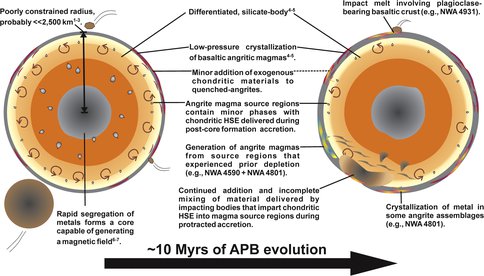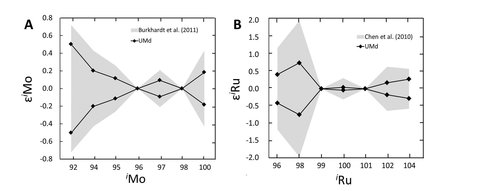2012 Annual Science Report
 NASA Goddard Space Flight Center
Reporting | SEP 2011 – AUG 2012
NASA Goddard Space Flight Center
Reporting | SEP 2011 – AUG 2012
Fingerprinting Late Additions to the Earth and Moon via the Study of Highly Siderophile Elements in Lunar Impact Melt Rocks
Project Summary
We have completed analysis of highly siderophile elements and Os isotopes in seven Apollo 17 impact melt breccias. The resulting large database for impact melt rocks from this site is consistent with a dominant signature imparted to rocks from this site by a single major impactor, most likely the Serenitatis impactor. The composition of this impactor was broadly chondritic, but characteristically enriched in Re, Ru and Pd relative to most chondrites. Studies of diogenites and angrites show that late accretion to small bodies occurred very early in solar system history.
Project Progress
In the past year, GCA Co-Investigator Walker and colleagues at the University of Maryland (Dept. of Geology) have focused on three major goals.
1. Completion of analysis of Apollo 17 impact melt rocks.
We have now completed the analysis of a suite of seven, diverse Apollo 17 lunar impact melt rocks for highly siderophile element (HSE: Re, Os, Ir, Ru, Pt, and Pd) abundances and Os isotopes (in addition to the three we previously analyzed in Puchtel et al., 2008). This work has comprised a major part the Ph.D. dissertation project of UMd student Miriam Sharp. The overarching purpose of this work has been to fingerprint the HSE characteristics of late heavy bombardment (~4.0 to 3.8 Ga) additions to the Moon (and presumably the Earth). We do this using the relative abundances of the HSE that occur in generally high abundance in likely lunar impactors (e.g., chondritic meteorites), but in extremely low abundance in the indigenous lunar crust. Our work on the Apollo 17 suite has been predicated on obtaining data for a sufficient number of samples to make a statistically meaningful assessment of the dominant impactor signature at a single landing site. In addition to characterizing the dominant HSE signature of the impactor(s), another major objective of this work has been to document the level of impactor homogeneity/heterogeneity present at the Apollo 17 site. Finally, this study has constantly sought to test the hypothesis that the impactor HSE fingerprint is recorded with a high degree of fidelity in impact melt rocks, despite the high energy processes that that acted on the rocks during the progression of basin-scale impacts. Towards this end, in the past year we separated small metal grains from one melt rock to assess whether or not the HSE were fractionated during the production of the metal grains. Because of the high abundances of HSE in the metal, such fractionations could profoundly obscure the nature of the impactor signature.
As previously noted (e.g., Puchtel et al., 2008), but now with a much larger sample population, the impactor signature that dominates Apollo 17 melt rocks with a poikilitic texture is generally characterized by Os/Ir and Pt/Ir ratios well within the range of chondritic meteorites, but higher averaged 187Os/188Os (long-term Re/Os), Ru/Ir and Pd/Ir ratios than most bulk chondrites (Fig. 1). One of the two aphanites (a rare impact melt rock lithology found at the Apollo 17 site) analyzed by our group, 73235, has an HSE signature that overlaps with the signature defined by the dominant, poikilitic melt rocks. The similarity of HSE characteristics of most of these melt rocks is, therefore, consistent with the interpretation that most melt rocks at the Apollo 17 site are dominated by a single impactor signature. The Apollo 17 landing site is located at the edge of the Serenitatis basin, so the most likely HSE signature present in the melt rocks is from that basin-forming impactor. However, it has also been proposed that the later Imbrium event overprinted the original Serenitatis impactor signature. The consistency of most of our data is more consistent with a Serenitatis signature at this time.
There remain some complexities in our dataset. We also analyzed one granulitic inclusion taken from a poikilitic breccia, which likely formed in an event prior to the dominant basin-forming event (it may be considerably older). It, as well as poikilitic sample 76055 have HSE characteristics that are considerably different from the dominant signature. Their compositions overlap with enstatite and carbonaceous chondrites, and may represent small impact events, or the proposed Imbrium overprint. Metal grains extracted from melt rock 76135 show some variability in HSE and Os isotopic ratios, suggesting that fractionation of HSE within melt rocks occurred, and may account for some of the scatter observed among data for some other melt rocks. The averaged ratops of the metals, however, are in good agreement with the bulk melt rock, such that the regression-based reconstructions of the signature generated for each rock is likely representative of the impactor. A manuscript reporting all of these data is currently being prepared as a chapter of Miriam Sharp’s dissertation. We expect it will be submitted for publication before the end of 2012.
1. 187Os/188Os vs. Ru/Ir for lunar impact melt rocks. The suffix A refers to aphanitic samples; P refers to poikilitic. Error bars show regression uncertainties. For comparison, bulk chondrite data are also plotted.
2. Timing of Late Accretion.
Late accretion of <1% mass to the terrestrial planets is a potential mechanism for the late delivery of organics and water to planets whose primary accretion may have consisted of large scale oligarchic growth that precluded the retention of volatiles. Timing, therefore, is an important factor that may have defined the nature of materials involved in late accretion. Two studies, partially supported by this grant, that have been published in the past year address the issue of late accretionary timing onto small bodies. One study examined the HSE present in diogenite meteorites, presumed to be derived from the asteroid Vesta (Day et al., 2012). The other study examined HSE in angrite meteorites (Riches et al., 2012). Both achondrite groups formed on bodies that melted and differentiated within a few million years of the formation of the solar system. These studies revealed the presence of HSE with chondritic relative abundances in most meteorites from both parent bodies. The studies reached similar conclusions that materials with bulk chondritic compositions were added to the mantles of the parent bodies after substantial magma ocean solidification and during a subsequent stage of vigorous convective mixing (Fig. 2). The old ages obtained for crustal materials from both bodies requires that late accretion to these bodies occurred within a few million years of solar system formation.
2. Schematic evolution of angrite parent body (APB) showing initial differentiation and magma ocean stage, followed by rapid crystallization and reintroduction of HSE to mantle materials via late accretion. The very short time frame for APB evolution requires that late accretion to this body occurred very early in solar system history. Late accretion to bodies such as the Earth and Moon occurred much later, suggesting that the timing of late accretion scaled with planetary body size. Figure is from Riches et al. (2012).
3. Development of new tools for fingerprinting late accreted materials.
Important discoveries relating to isotopic heterogeneity of the solar nebula were recently published in Geochimica et Cosmochimica Acta (Chen et al., 2010; Burkhardt et al., 2011). In these papers, the authors report large isotopic variations in the HSE Ru amd the moderately siderophile element molybdenum, among different types of meteorites, including among chondrite groups for Mo. These variations presumably resulted from the formation of parent bodies composed of varying mixtures of diverse nucleosynthetic components. The isotopic variations among the different types of chondritic meteorites are larger than have been identified for other elements. Both Mo and Ru, therefore, may become key isotopic tracers for late accreted materials. In lunar impact melt rocks, the mass balance between indigenous lunar Mo and impactor Mo, while not as favorable as for HSE (including Ru), should be sufficient to permit isotopic characterization of Mo in impactor materials.
We have begun refining chemical separation and mass spectrometric techniques for analyzing Ru and Mo isotopes. This work is being spearheaded by UMd Ph.D. student Emily Worsham, for Mo and by Katherine Bermingham, for Ru. At this time, our analytical capabilities are slightly improved over the published methods (Fig. 3).
3. Current 2σ SD external reproducibility of Mo (A) and Ru (B) isotopic ratios of standard reference materials, measured by thermal ionization mass spectrometry at UMd in comparison to the reported 2σ external reproducibilities reported by Burkhardt et al. (2011) for Mo (using MC-ICP-MS) and Chen et al. (2010) using TIMS. Molybdenum and Ru ratios are fractionation corrected using 96Mo/98Mo and 99Ru/100Ru, respectively.
Publications
-
Day, J. M. D., Walker, R. J., Qin, L., & Douglas Rumble, I. I. I. (2012). Late accretion as a natural consequence of planetary growth. Nature Geosci, 5(9), 614–617. doi:10.1038/ngeo1527
-
Riches, A. J. V., Day, J. M. D., Walker, R. J., Simonetti, A., Liu, Y., Neal, C. R., & Taylor, L. A. (2012). Rhenium–osmium isotope and highly-siderophile-element abundance systematics of angrite meteorites. Earth and Planetary Science Letters, 353-354, 208–218. doi:10.1016/j.epsl.2012.08.006
-
PROJECT INVESTIGATORS:
-
PROJECT MEMBERS:
Richard Walker
Co-Investigator
Igor Puchtel
Collaborator
-
RELATED OBJECTIVES:
Objective 1.1
Formation and evolution of habitable planets.


